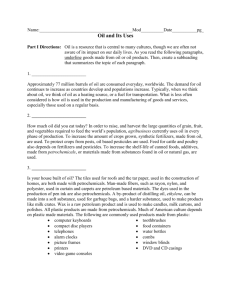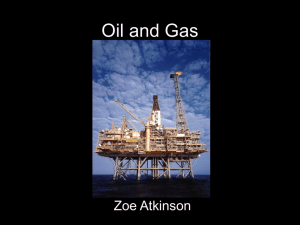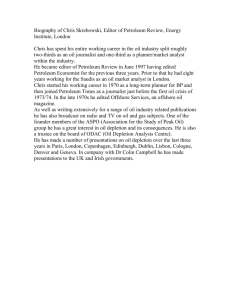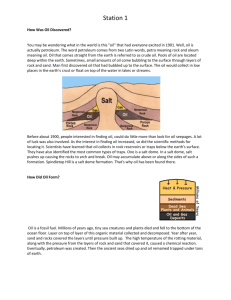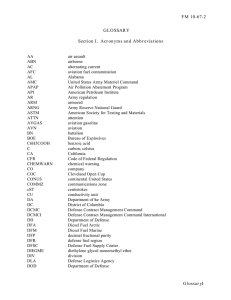Chapter 15: Financial Markets and Expectations
advertisement
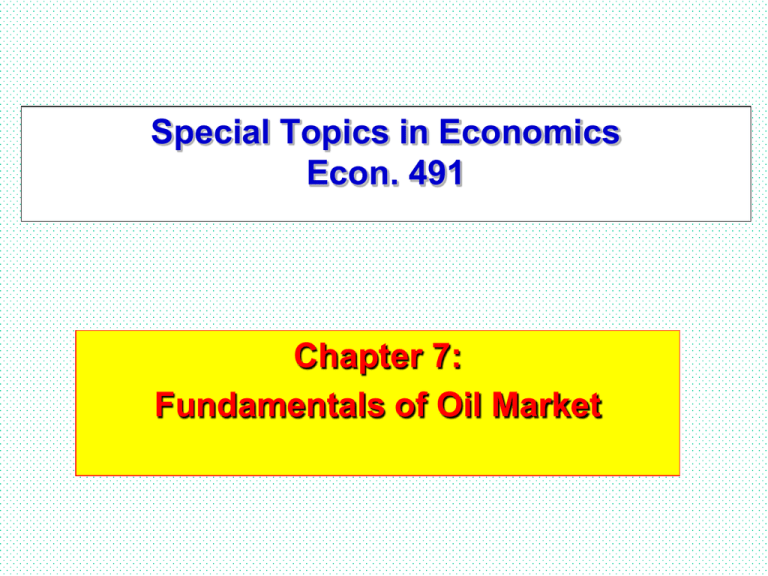
Special Topics in Economics Econ. 491 Chapter 7: Fundamentals of Oil Market I. Introduction The discovery of petroleum and the development of its useful products have made possible a giant leap in the living conditions of mankind. The word petroleum is a Latin word which means two words; “petr” means a rock, and “oleum” means fossil oil . According to studies of structural geology, the place of the petroleum can be found and then it is recovered mostly through oil drilling. II. Retail Sales of Petroleum Products Products and services use some forms of petroleum. Fuel and electricity are often used in housing; Clothing uses petroleum based synthetic fabrics; Producing food needs fertilizers and pesticides. Marketable petroleum can be divided into broad classes that provide for transportation, electrical generation and industry, home and commerce, agriculture, and petrochemicals. These general area are supplied by different cuts of crude ( separated by their boiling points from high to low). This is including gases, liquefied petroleum gas, gasoline, aviation fuels, kerosine, diesel fuel, lubricating oils, waxes, fuel oils, and miscellaneous products. consumers of car fuels experience the effects of petroleum marketing most directly at the retail outlet. The marketing chain of operations moves from refiner to distributor to retailer, and finally to the consumer. III. Needs of Petroleum 1- Aviation fuel The need for air transport fuels has developed dramatically in this century. This is as the size, capacity, and number of worldwide airliners have all increased. The demands placed on fuel quality for aircraft are more than those for car’s fuel. Aviation fuel must be free of contaminants (water or dirt) and be pumpable at low temperatures. 2- Electrical Generation & Industry The industrial sector consumes more than half of the total output of the world’s petroleum products. A large portion, especially natural gas, goes into the creation of electricity at generating plants.. Oil and coal are also fuel sources for generating plants. The gas, oil, or coal is burned to heat water that provides steam to turn turbines. The energy created by turbines is converted by generators into electiricty. 3- Home and Commerce The conversion from solid fuel to oil for heating the home has been widespread in this century. Since the 1973 rise in crude prices, the use of gas and electricity has intensified. Both gas and electricity provide the convenient aspect of being piped and wired into the consumer’s property, while oil has to be delivered by trucks. Natural gas has become the major competitor to oil for heating. The electricity is usually a more expensive alternative for heating. Although gas and electricity are used increasingly for residences, the heating oil continues to be marketed to heat commercial buildings such as hospitals, schools, and factors. 4- Agriculture Petroleum products play a vital role in farming today . Using the internal combustion engine to power the tractor was greatly responsible for transforming the traditional rural farm into a modern industry. The development of diesel fuels and liquefied petroleum gas for tractors and other mechanized implements has revolutionized farming. Other important petroleum derivatives used for agriculture are the chemicals used for fertilizer. 5- Petrochemicals Marketing petrochemicals is different in several aspects . Few petrochemicals are end products themselves. They are usually intermediate chemicals that are sold to manufactures. Factory processes then turn them into such articles as tires, fabrics, plastics, and a host of other products. Volumes of petrochemicals are relatively small compared to gasolines and fuel oils . IV. Some Facts about Oil Production Top ten oil-producing countries accounted for over 63% of the world's oil production in 2011. There are three countries that are competing to be the largest oil producer in the world. Who are they?. The USA remains by far the largest user of oil. Oil Production By Country: Country Production (bbl/day) Share of World % World 84,820,000 100% 1 Russia 10,900,000 13.28% 2 Saudi Arabia 9,900,000 12.65% 3 United States 8,453,000 9.97% 4 Iran 4,231,000 4.77% 5 China 4,073,000 4.56% 6 Canada 3,592,000 3.90% 7 Iraq 3,400,000 3.75% 8 United Arab Emirates 3,087,000 3.32% 9 Venezuela 3,023,000 4.74% 10 Mexico 2,934,000 3.56% 11 Kuwait 2,682,000 2.96% 12 Brazil 2,633,000 3.05% 13 Nigeria 2,525,000 2.62% 14 Norway 1,998,000 2.79% 15 Algeria 1,885,000 2.52% Rank Oil Consumption By Country: Rank Country/Region Oil - consumption (bbl/day) - World 93,250,000 1 United States 19,150,000 2 China 9,400,000 3 Japan 4,452,000 4 India 3,182,000 5 Saudi Arabia 2,643,000 6 Germany 2,495,000 7 Canada 2,209,000 8 Russia 2,199,000 9 Korea, South 2,195,000 10 Mexico 2,073,000 11 Brazil 2,029,000 12 France 1,861,000 13 Iran 1,845,000 14 United Kingdom 1,622,000 15 Italy 1,528,000 V. Oil Prices The trading currency for petroleum is the U.S. dollar (called Petrodollar). The price of a barrel of oil is highly dependent on both its grade, determined by factors such as its specific gravity or API (The American Petroleum Institute gravity) and its sulphur content, and its location. The demand for oil is highly dependent on global macroeconomic conditions.. Oil prices over time (1961-2011)
